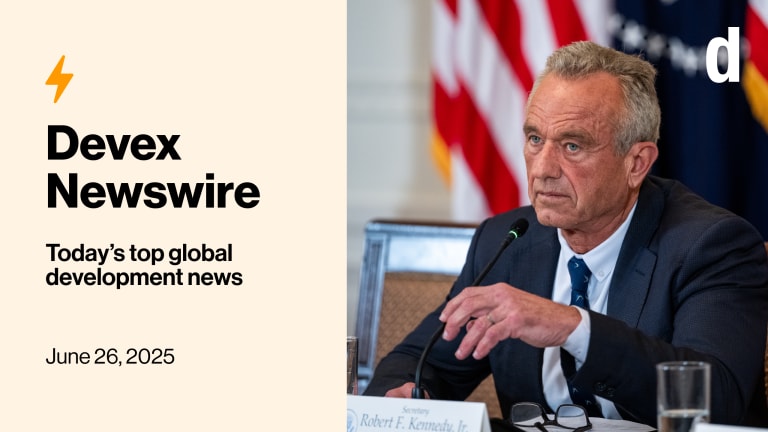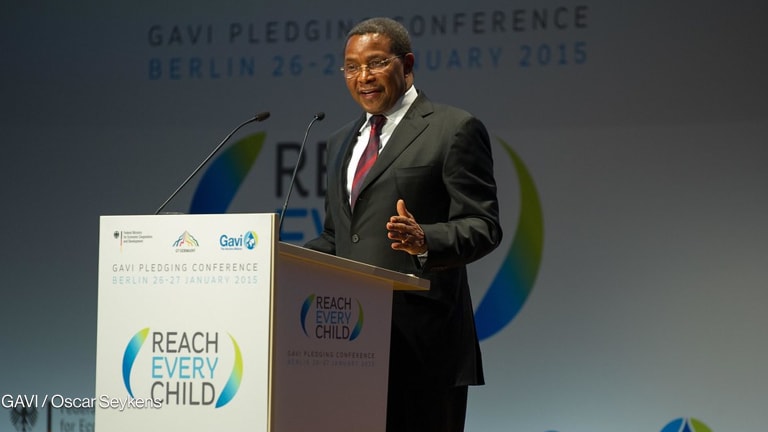
The GAVI Alliance is gearing up for a new replenishment, in which the organization plans to ask for more funds than it ever has before.
However, and while the alliance’s model has proven to be quite successful, three questions must be addressed before donors are once again requested to help vaccinate children around the world. The replenishment conference for GAVI’s next funding cycle — which will run from 2016 to 2020 — is expected to be held at the end of the year, but the alliance will likely announce its appeal during an EU development ministers meeting in Brussels in May.
GAVI has said that it will ask for more money than it did in its last pledging conference in 2011, when donors committed to giving $4.3 billion, even more than the $3.7 billion the alliance had requested. Those funds supplemented existing direct funding from donors and the International Financing Facility for Immunization — bringing the total amount being spent on the current cycle to about $7.4 billion.
As the alliance works to convince donors to step up, here are a few questions to consider:
1. How well has the GAVI model worked?
GAVI has immunized approximately 440 million children and prevented an estimated 6 million future deaths from diseases. It has also reduced vaccine prices, increased competition in the vaccine market, and helped make many more vaccines available to those living in developing countries. The alliance has also scaled up its vaccine rollout, and in 2015 expects to roll out 71 vaccines — not including the inactivated polio vaccine, up from 22 in 2011.
At a recent event at the Center for Strategic and International Studies, representatives of the U.S. Agency for International Development and the Bill & Melinda Gates Foundation praised GAVI.
“My impression or experience with GAVI is that it’s really grappling with some of the fundamental issues of development,” said Robert Clay, deputy assistant administrator at USAID’s Bureau of Global Health. “When you look at country ownership, reaching the fifth child, getting access out to the farthest reach, bringing in other partners [or] growing the pie — I think GAVI is on the cutting edge.”
Clay, a member of GAVI’s board and part of the alliance’s health systems strengthening group, explained that the early approach to health systems work did not achieve great results. As a result, GAVI has gone back to reconsider and try new ways to invest in and build the systems necessary to have sustainable vaccination programs, he said.
GAVI Alliance CEO Seth Berkley noted that managing funds and other management challenges are critical issues, and that while GAVI may not be able to fix entire systems, it can work with countries like Nigeria to have better accountability.
There are also certainly other challenges, some of which have been born of GAVI’s successes. GAVI now vaccinates four of five children worldwide with the basic vaccines. As with other development issues, reaching that “fifth child” is a challenge that requires special work and updated systems.
“High-quality data is critical,” Berkley said. “We need to be able to understand where they are, what the systems are, where the problems are and where vaccines are.”
2. Are GAVI countries moving toward greater co-financing and sustainable ownership of vaccine programs? As countries graduate, what is the alliance doing to ensure smooth transitions?
All countries participating in GAVI are required to contribute some money toward the vaccines they receive — the amount is determined on a sliding scale by ability to pay. The process of co-financing creates buy-in and often helps create budget line-items for vaccines in cases where governments did not previously have them, Berkley said.
As countries move toward graduation, they will contribute increasingly larger amounts to GAVI — Clay said that while recipient countries previously made up about 5 percent of contributions to the alliance, that number is expected to climb to about 15 percent in the next program period.
How to ensure smooth transitions out of GAVI and facilitating successful graduations are perhaps the key concerns moving forward, according to Berkley. About 20 of GAVI countries are expected to graduate between 2016 and 2020.
“What’s going to be critical is making sure that those countries have the maximum chance of success to be able to sustain those programs,” he said. In part, that means GAVI working with pharmaceutical companies to continue offering those countries GAVI pricing and only increasing those prices gradually over time in a way that will allow the country to continue to afford them.
The countries that present the greatest challenges as they graduate are likely to be those where commodities have driven wealth and, often, less has been reinvested in building necessary systems. GAVI is already working on how to best work with those countries and prop up the systems necessary for self-sufficiency, Berkley said.
He added that as GAVI continues to gather data, it considers not just national statistics but is also trying to get a more accurate sense of areas in a country where children may be less likely to be vaccinated so it can develop ways to reach them. As countries graduate, it will be important to ensure that distribution of vaccines is as equitable as possible.
3. Is it realistic that donors will pledge more to GAVI? What is the current appetite for investment?
Prediction is a challenge, but Berkley said he believes GAVI has a strong argument to make for greater support.
The next replenishment will likely be the largest in the alliance’s history because once the countries graduate in this next period, costs will come down. In the meantime, however, increased funds are necessary both to strengthen systems for smooth transitions and to purchase the 2.7 billion vaccine doses it predicts that it will need.
While there are always trade-offs in budget discussions, GAVI produces clear, tangible results, which is part of the reason why even in challenging budget times the United States — the alliance’s second largest donor — continues to support GAVI, Clay said.
The Gates Foundation, which has invested about $2.5 billion in GAVI to date, continues to support the alliance and looks forward to working with other donors to keep doing so in the future, noted Nicole Bates, deputy director for global policy and advocacy.
“Donor confidence is high,” she said, but with the challenging fiscal environment, GAVI must continue to do a good job articulating its value proposition and making the case.
Vaccines may also have something of a popularity problem, several of the speakers said at the event — while other health issues like HIV and AIDS, and malaria have drawn a lot of popular attention, vaccines and GAVI have largely operated quietly.
As the alliance looks to raise more funds, it has recognized that may include working to raise its profile. It has already started to do that by hiring Natasha Bilimoria, a former White House staffer and former president of Friends of the Global Fight Against AIDS, Tuberculosis and Malaria, to head up the U.S. portion of the replenishment.
GAVI will thus continue to work with existing donors, especially those like Germany and Japan, which are punching below their weight, and at the same time look to new sources of funding, including Middle East donors, from which the fund has gotten little support in the past.
Join Devex, the largest online community for international development, to network with peers, discover talent and forge new partnerships — it’s free. Then sign up for the Devex Impact newsletter to receive cutting-edge news and analysis every month on the intersection of business and development.
See more:
A new public-private strategy to combat malaria and tuberculosis
The benefits of PPPs in global health
GAVI needs partners to 'learn by doing'








